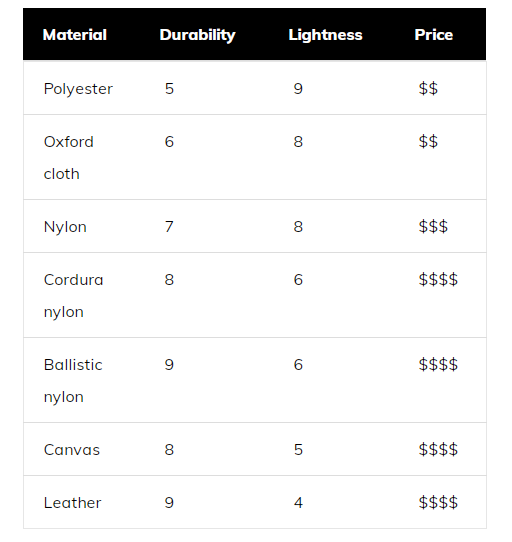Choosing a material for your softside luggage may be a little more complicated. There’s a far wider variety of materials that include: Polyester, Oxford cloth, Nylon, Ballistic Nylon, Cordura Nylon, Canvas, and Leather.

If you want something cost-effective, and don’t mind if the case is going to be less scratch and tear-resistant, Polyester and Oxford Cloth may be a good choice. However, if you want something more durable, you will have to pay a little more for a Nylon suitcase. Out of all nylons, Ballistic is the most durable, followed by Cordura and lastly regular nylon.
If you have a bigger budget and want something on the high-end of suitcases, try leather or canvas. For some, leather is also more aesthetically pleasing, though it is very expensive.
Polyester
All fabrics are measured in deniers – the mass of a single 9000m long thread. I know, it’s a weird way of measuring fabrics. I’ll try to explain though. For instance, a single silk thread that’s 9km long weighs 1 gram, which is one denier or 1D. Polyester threads usually range in the 300D-1800D, which means that a single polyester thread 9km in length would weigh 300g-1800g. As a rule, the more deniers, the more durable the material is.
Polyester is usually used in cheaper fabric suitcases because it’s less expensive than nylon. When looking at its properties, polyester is less durable and less scratch & tear-resistant than nylon or canvas. However, it weighs slightly less than nylon, which is a good thing. When looking at polyester suitcases, try to get at least 800D nylon, which is somewhat durable.
Oxford Cloth
Oxford cloth is a breathable basket weave cloth originally made from cotton, however today it’s often blended with other fabrics such as rayon and polyester. It’s the result of a particular basket weave process known as the Oxford weave, from where it gets its name.
In its time Oxford cloth has most commonly been used for clothing, particularly casualwear. However, it has recently become somewhat popular for its use elsewhere, such as window treatments, wall hanging, and duvet covers. It’s not unusual to see Oxford cloth used for suitcases as well, and the fabric has even been used by some leading brand names. For suitcases, the cloth is usually around 600D for water-resistance though material as high as 1680D, with exceptional abrasion and tear-resistance, can be found.
Nylon
Nylon is more expensive than polyester, hence the reason expensive luggage is usually made from this material.
In deniers, nylon fabrics usually range lower than polyester, but they also tend to be stronger. For instance a 450D nylon is going to be stronger than 600d polyester. This may be something you’ll want to keep in mind if you’re considering luggage made from either of the two. Nylon also happens to be more abrasion and tear-resistant, which is perfect for fabric suitcases. One thing to note is that nylon is somewhat heavier than polyester.
Ballistic Nylon
This material came into existence during the Second World War, as an American company’s attempt to make a “flak jacket”, i.e a form of body armor that might protect against bullet and artillery-shell shrapnel. Interesting huh? Unfortunately, Ballistic nylon failed to achieve this goal, but it is still being used for durable products today.
Although ballistic nylon is made from nylon, its properties are not exactly the same. It’s weaved differently and built from thicker and heavier threads (Usually 840D or 1050D). Although they couldn’t make it bulletproof, they did create a fabric that’s virtually travel-proof.
It’s mostly used in backpacks and other travel gear, which needs improved resistance. It has a rough feel to it, and it’s heavier than regular nylon. Compared to regular nylon or polyester, it’s more tear-resistant and abrasion-resistant.
Cordura Nylon
Cordura is another type of nylon, somewhat similar to Ballistic nylon. It was developed in the same era, and it’s similarly durable. Cordura is also made from nylon threads in the 1050D thickness.
This material is used in high-end travel gear that needs to be super durable and weather-resistant. The key difference from Ballistic nylon is that Cordura is more abrasion-resistant and looks more similar to Canvas. Also, it’s not as tear-resistant as Ballistic nylon. Both materials are exceptionally strong, and both are good choices for fabric travel products, like backpacks and luggage.
Canvas
Canvas is a woven fabric made from cotton, hemp, or a blend. Although it’s rarely used in luggage, it’s pretty common in backpacks and other travel products.
It’s stronger than regular polyester, but not as strong as nylon. Because it’s made from organic materials instead of plastics, it’s not as weatherproof and can start to rot if left in damp conditions. It’s also heavier than polyester or nylon and can get pretty expensive. Due to its more-natural looks, it’s more common in backpacks, duffel bags, and jackets, instead of suitcases.
Leather
Although leather was widely used for suitcases in the ’50s, it was quickly outperformed by fabric, aluminum, and plastic. Nowadays, it’s hard to find leather suitcases, except for some high-end options that celebrate the old-fashioned look, like Globe-trotter. However, leather is still widely used in handbags, backpacks, and duffel bags.
Leather bags are much more durable than polyester and most nylon bags. If properly treated, they could last a lifetime. The main disadvantage of leather bags is that they’re incredibly heavy, not as weather-resistant, and expensive.
Contact: Starry Fung
Phone: +86-1-3926-559500
E-mail: starry.fung@binhao.com
Add: No.82, North Dongkeng Avenue, Dongkeng Town, Dongguan, Guangdong, China 523446